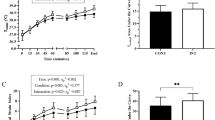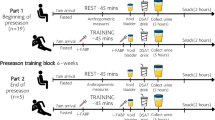Abstract
Purpose
Endurance exercise and hyperthermia are associated with compromised intestinal permeability and endotoxaemia. The presence of intestinal fatty acid-binding protein (I-FABP) in the systemic circulation suggests intestinal wall damage, but this marker has not previously been used to investigate intestinal integrity after marathon running.
Methods
Twenty-four runners were recruited as controls prior to completing a standard marathon and had sequential I-FABP measurements before and on completion of the marathon, then at four and 24 h later. Eight runners incapacitated with exercise-associated collapse (EAC) with hyperthermia had I-FABP measured at the time of collapse and 1 hour later.
Results
I-FABP was increased immediately on completing the marathon (T0; 2593 ± 1373 ng·l−1) compared with baseline (1129 ± 493 ng·l−1; p < 0.01) in the controls, but there was no significant difference between baseline and the levels at four hours (1419 ± 1124 ng·l−1; p = 0.7), or at 24 h (1086 ± 302 ng·l−1; p = 0.5). At T0, EAC cases had a significantly higher I-FABP concentration (15,389 ± 8547 ng.l−1) compared with controls at T0 (p < 0.01), and remained higher at 1 hour after collapse (13,951 ± 10,476 ng.l−1) than the pre-race control baseline (p < 0.05).
Conclusion
I-FABP is a recently described biomarker whose presence in the circulation is associated with intestinal wall damage. I-FABP levels increase after marathon running and increase further if the endurance exercise is associated with EAC and hyperthermia. After EAC, I-FABP remains high in the circulation for an extended period, suggesting ongoing intestinal wall stress.


Similar content being viewed by others
Availability of data and material
The datasets generated during and/or analysed during the current study are available from the corresponding author on reasonable request.
Code availability
Not applicable.
Abbreviations
- DBP:
-
Diastolic blood pressure
- EAC:
-
Exercise-associated collapse
- EHI:
-
Exertional heat illness
- EHS:
-
Exertional heat stroke
- GI:
-
Gastro-intestinal
- HR:
-
Heart rate
- I-FABP:
-
Intestinal fatty acid-binding protein
- MAP:
-
Mean arterial pressure
- SBP:
-
Systolic blood pressure
- SpO2 :
-
Peripheral oxygen saturation
- TTYM :
-
Tympanic temperature
References
Armstrong L, Casa D, Millard-Stafford M, Moran D, Pyne S, Roberts W (2007) Exertional heat illness during training and competition. Med Sci Sports Exerc 39(3):556–572
Badoer E (2010) Role of the hypothalamic PVN in the regulation of renal sympathetic nerve activity and blood flow during hyperthermia and in heart failure. Am J Physiol Renal Physiol 298(4):F839–F846
Camus G, Poortmans J, Nys M et al (1997) Mild endotoxaemia and the inflammatory response induced by a marathon race. Clin Sci 92:415–422
Casa DJ, Becker SM, Ganio MS, Brown CM, Yeargin SW, Roti MW, Siegler J, Blowers JA, Glaviano NR, Huggins RA, Armstrong LE, Maresh CM (2007) Validity of devices that assess body temperature during outdoor exercise in the heat. J Athl Train 42(3):333–342
Coelho AMM, Sampietre S, Machado MC, Cunha JEM, Chaib E, D’Albuqueque LAC (2016) Intestinal fatty acid binding protein (I-FABP) is a marker of bacterial translocation in experimental acute pancreatitis. HPB 18(Suppl 1):e333
Costa RJS, Snipe RMJ, Kitic CM, Gibson PR (2017) Systematic review: exercise-induced gastrointestinal syndrome-implications for health and intestinal disease. Aliment Pharmacol Ther 46(3):246–265
Crandall CG, Wilson TE (2015) Human cardiovascular responses to passive heat stress. Compr Physiol 5(1):17–43
Dokladny K, Moseley PL, Ma TY (2006) Physiologically relevant increase in temperature causes an increase in intestinal epithelial tight junction permeability. Am J Physiol Gastrointest Liver Physiol 290(2):G204–G212
Funaoka H, Kanda T, Fujii H (2010) Intestinal fatty acid-binding protein (I-FABP) as a new biomarker for intestinal diseases [Article in Japanese]. Rinsho Byori 58(2):162–168
Gibson OR, Turner G, Tuttle JA, Taylor L, Watt PW, Maxwell NS (2015) Heat acclimation attenuates physiological strain and the HSP72, but not HSP90α, mRNA response to acute normobaric hypoxia. J Appl Physiol (1985) 119(8):889–899
Gibson OR, Tuttle JA, Watt PW, Maxwell NS, Taylor L (2016) Hsp72 and Hsp90α mRNA transcription is characterised by large, sustained changes in core temperature during heat acclimation. Cell Stress Chaperones 21(6):1021–1035
Halvorsen FA, Lyng J, Glomsaker T, Ritland S (1990) Gastrointestinal disturbances in marathon runners. Br J Sports Med 24:266–268
Jaworski CA, Rygiel V (2020) Exercise-associated collapse: on-the-field and in-office assessment. In: Harrast MA (ed) Clinical Care of the Runner, 1st edition, Elsevier, pp 27–37
Kanda T, Tsukahara A, Ueki K et al (2011) Diagnosis of ischemic small bowel disease by measurement of serum intestinal fatty acid-binding protein in patients with acute abdomen: a multicenter, observer-blinded validation study. J Gastroenterol 46(4):492–500
Koch F, Thom U, Albrecht E et al (2019) Heat stress directly impairs gut integrity and recruits distinct immune cell populations into the bovine intestine. Proc Natl Acad Sci U S A 116(21):10333–10338
Laitano O, Leon LR, Roberts WO, Sawka MN (2019) Controversies in exertional heat stroke diagnosis, prevention, and treatment. J Appl Physiol (1985) 127(5):1338–1348
Lim CL (2018) Heat sepsis precedes heat toxicity in the pathophysiology of heat stroke-a new paradigm on an ancient disease. Antioxidants (Basel) 7(11):149
Lüning H, Mangelus C, Carlström E, Nilson F, Börjesson M (2019) Incidence and characteristics of severe exercise-associated collapse at the world’s largest half-marathon. PLoS ONE 14(6):e0217465
March DS, Marchbank T, Playford RJ, Jones AW, Thatcher R, Davison G (2017) Intestinal fatty acid-binding protein and gut permeability responses to exercise. Eur J Appl Physiol 117(5):931–941
Memet O, Zhang L, Shen J (2019) Serological biomarkers for acute mesenteric ischemia. Ann Transl Med 7(16):394
Nava R, Zuhl MN (2020) Heat acclimation-induced intracellular HSP70 in humans: a meta-analysis. Cell Stress Chaperones 25:35–45
Nichols AW (2014) Heat-related illness in sports and exercise. Curr Rev Musculoskelet Med 7(4):355–365
Niven DJ, Laupland KB (2016) Pyrexia: aetiology in the ICU. Crit Care 20:247
Périard JD, Travers GJS, Racinais S, Sawka MN (2016) Cardiovascular adaptations supporting human exercise-heat acclimation. Auton Neurosci 196:52–62
Pires W, Veneroso CE, Wanner SP et al (2017) Association between exercise-induced hyperthermia and intestinal permeability: a systematic review. Sports Med 47(7):1389–1403
Racinais S, Moussay S, Nichols D et al (2019) Core temperature up to 41.5 °C during the UCI road cycling world championships in the heat. Br J Sports Med 53(7):426–429
Smetanka RD, Lambert GP, Murray R, Eddy D, Horn M, Gisolfi CV (1999) Intestinal permeability in runners in the 1996 Chicago marathon. Int J Sport Nutr 9(4):426–433
Snipe RMJ, Khoo A, Kitic CM, Gibson PR, Costa RJS (2018) The impact of exertional-heat stress on gastrointestinal integrity, gastrointestinal symptoms, systemic endotoxin and cytokine profile. Eur J Appl Physiol 118(2):389–400
Stevens CJ, Ross ML, Périard JD, Vallance BS, Burke LM (2020) Core temperature responses to elite racewalking competition. Int J Sports Physiol Perform 4:1–4
Thuijls G, van Wijck K, Grootjans J, Derikx JP, van Bijnen AA, Heineman E, Dejong CH, Buurman WA, Poeze M (2011) Early diagnosis of intestinal ischemia using urinary and plasma fatty acid binding proteins. Ann Surg 253(2):303–308
Tyler CJ, Reeve T, Hodges GJ, Cheung SS (2016) The effects of heat adaptation on physiology, perception and exercise performance in the heat: a meta-analysis. Sports Med 46(11):1699–1724
van de Poll MCG, Derikx JPM, Buurman WA et al (2007) Liver manipulation causes hepatocyte injury and precedes systemic inflammation in patients undergoing liver resection. World J Surg 31:2033–2038
van Wijck K, Lenaerts K, van Loon LJC, Peters WH, Buurman WA, Dejong CH (2011) Exercise-induced splanchnic hypoperfusion results in gut dysfunction in healthy men. PLoS ONE 6(7):e22366
Van Wijck K, Wijnands KAP, Meesters DM et al (2014) L-Citrulline improves splanchnic perfusion and reduces gut injury during exercise. Med Sci Sports Exerc 46(11):2039–2046
Vicario SJ, Okabajue R, Haltom T (1986) Rapid cooling in classic heatstroke: effect on mortality rates. Am J Emerg Med 4:394–398
Vlad M, Ionescu N, Ispas AT, Giuvarasteanu I, Ungureanu E, Stoica C (2010) Morphological changes during acute experimental short-term hyperthermia. Rom J Morphol Embryol 51(4):739–744
Walter E, Gibson O (2020) The efficacy of antibiotics in reducing morbidity and mortality from heatstroke—a systematic review. J Therm Biol 2020(88):102509
Walter EJ, Hanna-Jumma S, Carraretto M, Forni L (2016) The pathophysiological basis and consequences of fever. Crit Care 20:200
Walter EJ, Galloway R, Stacey M, Martin D, Roiz de sa D, Robertson B, Kipps C (2018). Exertional Heat Stroke (position statement): The Faculty of Sport and Exercise Medicine (FSEM) UK. https://www.fsem.ac.uk/position_statement/exertional-heat-stroke/. Accessed 4 Dec 2020
Acknowledgements
The authors declare that the results of the study are presented clearly, honestly, and without fabrication, falsification or inappropriate data manipulation. The authors acknowledge the following with grateful thanks: the statistical advice of Dr Louise Lloyd, the assistance of the Brighton Marathon medical management team (Dr Rob Galloway, Dr Rachel Grimaldi and Ms Carrie Weller) in facilitating the research, Prof Steve Brett (Imperial College, London) for his invaluable assistance with the planning of the study. Ms Tracy Neal (Affinity laboratory director) for her advice and facilitating the sample analysis.
Funding
The authors acknowledge with grateful thanks the financial assistance of the Surgeon General, Defence Medical Services.
Author information
Authors and Affiliations
Contributions
All authors contributed to the design of the work, and the acquisition and analysis of the data. All authors were involved with the writing of the paper, and all have seen and approved the final version. OG provided further statistical analysis of the data.
Corresponding author
Ethics declarations
Conflict of interest
No authors declare any competing interests.
Ethics approval
Ethical approval was obtained from the London-South East Research Ethics Committee.
Consent to participate
Informed consent was obtained from all individual participants included in the study.
Consent for publication
Informed consent was obtained from all individual participants included in the study.
Additional information
Communicated by Fabio Fischetti.
Publisher's Note
Springer Nature remains neutral with regard to jurisdictional claims in published maps and institutional affiliations.
Rights and permissions
About this article
Cite this article
Walter, E., Gibson, O.R., Stacey, M. et al. Changes in gastrointestinal cell integrity after marathon running and exercise-associated collapse. Eur J Appl Physiol 121, 1179–1187 (2021). https://doi.org/10.1007/s00421-021-04603-w
Received:
Accepted:
Published:
Issue Date:
DOI: https://doi.org/10.1007/s00421-021-04603-w




